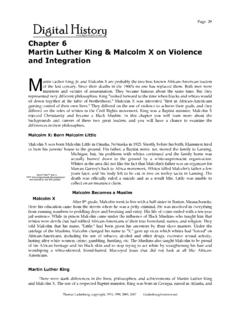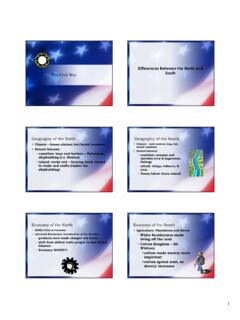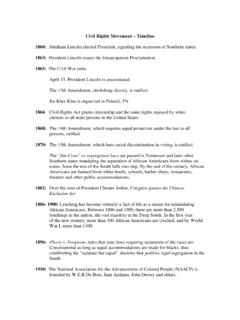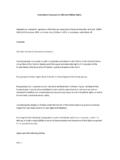Transcription of Civil Rights Quiz - Bob Alley
1 Civil Rights Quiz 1) The Civil Rights Act of 1964 prohibits employment that discriminates based on A) race, national origin, and pregnancy. B) race, creed, color, and religion. C) color, alienage, sex, and religion. D) race, sex, religion, and wealth. E) religion and sex only. 2) _____ was the first major national crisis over slavery. A) Shays's Rebellion B) The Missouri Compromise C) Dred Scott v. Sandford D) The Niagara movement E) The Seneca Falls Convention 3) _____ was a well-known abolitionist who edited the North Star.
2 A) William Lloyd Garrison B) Lucretia Mott C) Frederick Douglass D) Elizabeth Cady Stanton E) Harriet Beecher Stowe 4) Abolitionists worked toward A) ending slavery. B) abolishing suffrage limits for women. C) continuing the slave trade. D) the emancipation of women. E) eliminating discrimination for all Americans. 5) The World Anti-Slavery Society refused to A) admit Frederick Douglass as a member. B) admit more than 200,000 members. C) accept women's demands for equality. D) react to the Missouri Compromise.
3 E) seat black delegates to its convention. 6) Why did the World Anti-Slavery Society MOST likely refuse to accept women s demands for equality? A) They felt like women had not worked hard enough for equality. B) No women had sought to join forces with the organization. C) Women were seen largely as racist. D) Members of the organization feared that fighting for both African Americans and women s Rights would be too ambitious of a goal to attain. E) Women already had more Rights than African Americans, such as the right to vote.
4 7) The Seneca Falls Convention was A) called to draw additional attention to slavery. B) called to help implement the Missouri Compromise. C) a meeting in preparation for the World Anti-Slavery Society convention. D) held to discuss the Civil and political Rights of women. E) actually held in the city of New York. 8) In Dred Scott v. Sandford, the Supreme Court ruled that slaves were A) not to be counted the same as whites when counting state population. B) not citizens. C) citizens. D) prohibited in the North.
5 E) allowed to bring suits in federal courts. 9) Slavery was banned by the _____ Amendment. A) Twelfth B) Thirteenth C) Fourteenth D) Fifteenth E) Sixteenth 10) Abolitionists' support of the Fifteenth Amendment led A) to ratification ten years later. B) women's Rights activists also to support the amendment. C) Susan B. Anthony and Elizabeth Cady Stanton to form a women s Rights group. D) to greater racial equality. E) only Southern blacks to get the right to vote. 11) The existence of two schools on opposite sides of town one for Caucasian students and the other for African American students would have been deemed constitutional after the Supreme Court s ruling in which of the following cases?
6 A) Plessy v. Ferguson B) Brown v. Board of Education C) Civil Rights Cases D) Bradwell v. Illinois E) Reed v. Reed 12) In _____, the Supreme Court found that segregation of rail transportation was constitutional because separate but equal accommodations did not violate the equal protection clause of the Fourteenth Amendment. A) Civil Rights Cases B) Slaughterhouse Cases C) Plessy v. Ferguson D) Bradwell v. Illinois E) Brown v. Board of Education 13) In 1905, DuBois met with other African Americans in Niagara Falls, Ontario, Canada, to A) found the National Association for the Advancement of Colored People.
7 B) advance the cause of African Americans through the Niagara movement . C) meet in the only place that would allow whites and blacks to meet. D) create a lobbying strategy for the woman suffrage amendment. E) propose a new anti-discrimination constitutional amendment. 14) The suffrage movement A) promoted broad social issues. B) had racist overtones. C) promoted voting Rights for blacks. D) advocated equal Rights for women. E) led to passage of the Eighteenth Amendment. 15) The NAACP began its litigation strategy to end segregation by challenging segregation in A) public accommodations.
8 B) elementary schools. C) private housing projects. D) employment. E) law and graduate schools. 16) Why did the NAACP MOST likely begin its test case litigation strategy in law schools? A) They envisioned a top-down strategy. B) The lawyers felt that targeting law schools would make the cases easier for judges to understand and thus easier to win. C) Law schools had more discriminatory policies than other educational institutions. D) Law schools were high profile institutions. E) Most of the NAACP lawyers took the discrimination they felt in law school personally.
9 17) As president, _____ had his administration file an amicus curiae brief in Brown v. Board of Education and issue an executive order desegregating the military. A) Franklin D. Roosevelt B) Harry S Truman C) Dwight D. Eisenhower D) Jimmy Carter E) John F. Kennedy 18) The Supreme Court was influenced by _____in Brown v. Board of Education. A) the separate but equal doctrine. B) a study of children's reactions to black and white dolls. C) amicus curiae briefs from several southern states. D) Black Monday.
10 E) the success of northern states desegregation efforts. 19) President Dwight D. Eisenhower was forced to _____ to protect African American students seeking entry into Central High School in Little Rock, Arkansas. A) order the governor to allow students to attend the school B) send federal troops to Little Rock C) order a federal judge to issue an injunction D) jail the governor for contempt E) seek congressional assistance 20) In 1955, the Montgomery bus boycott began after _____ refused to give up his/her seat on a public bus.







